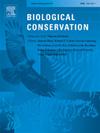Supporting biocultural connections in conservation translocations
IF 4.9
1区 环境科学与生态学
Q1 BIODIVERSITY CONSERVATION
引用次数: 0
Abstract
Translocation is an important tool to restore populations and safeguard species from anthropogenic climate change, habitat destruction and other threats. However, translocation decision-making rarely accounts for relationships of place between species and Indigenous Peoples. We aimed to investigate how archival and geographical sources related to mātauranga (Indigenous Māori knowledge) might inform conservation efforts such as translocations. In particular, we focused on the ecology of and human relationships with a forest-dwelling parrot, the kākā (Nestor meridionalis) in Aotearoa New Zealand (AoNZ). We mapped Māori place names associated with kākā, overlaying these with the current reported distribution for kākā from iNaturalist. Names often occurred in clusters, with some of the largest clusters in areas where kākā are considered regionally extinct. We also examined street names, but most were modern subdivision assignations, and not informative of place-based biocultural relationships. Our searches of historical print archives (newspapers, magazines and journals) from 1842 to 1984 revealed a range of kākā-related material. Early references to kākā in magazines and journals (1861–2017) focused on ecology, reflecting mātauranga, but later references focused on legislation. Taken together, these sources show temporal changes in both geographical distribution and the nature of discussion in historical written sources around kākā and Māori relationships in AoNZ. We argue that partnering with local communities is also critical to understanding these relationships. We recommend that future translocation decision-making should incorporate the relationships and place-based knowledge of Indigenous and other local communities. In doing so, translocations have the potential to revitalise diminished human-wildlife connections and restore species in and of themselves as well as biocultural connections and biodiversity.
求助全文
约1分钟内获得全文
求助全文
来源期刊

Biological Conservation
环境科学-环境科学
CiteScore
10.20
自引率
3.40%
发文量
295
审稿时长
61 days
期刊介绍:
Biological Conservation is an international leading journal in the discipline of conservation biology. The journal publishes articles spanning a diverse range of fields that contribute to the biological, sociological, and economic dimensions of conservation and natural resource management. The primary aim of Biological Conservation is the publication of high-quality papers that advance the science and practice of conservation, or which demonstrate the application of conservation principles for natural resource management and policy. Therefore it will be of interest to a broad international readership.
 求助内容:
求助内容: 应助结果提醒方式:
应助结果提醒方式:


